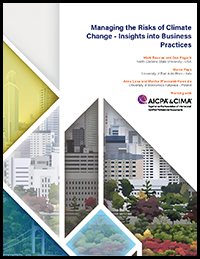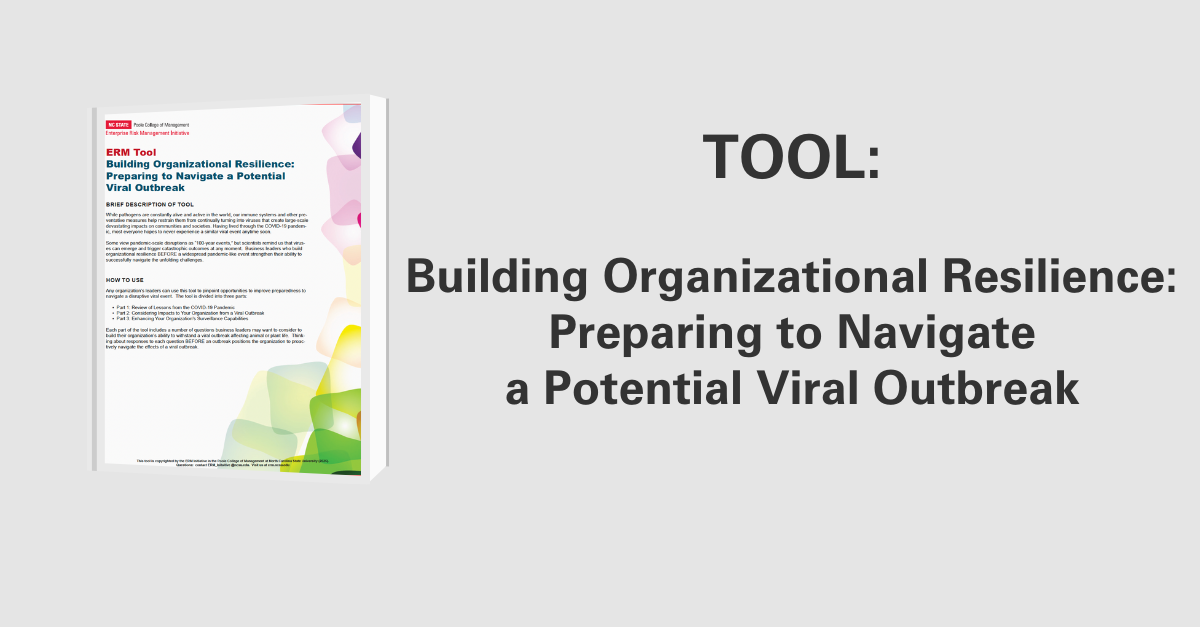Managing the Risks of Climate Change – Insights into Business Practices
Mark Beasley and Don Pagach | North Carolina State University - USA
Marco Papa | University of Bari Aldo Moro - Italy
Anna Losa and Monika Wieczorek-Kosmala | University of Economics Katowice - Poland

The ERM Initiative at NC State is pleased to provide this report, Managing the Risks of Climate Change – Insights into Business Practices, in partnership with research colleagues at the University of Bari Aldo Moro in Italy and the University of Economics Katowice in Poland and with the assistance of the AICPA & Chartered Institute of Management Accountants (CIMA).
This report provides insights as to how organizations are designing processes and procedures to address current climate-related risk management expectations and regulations in the global marketplace.
Based on survey responses from 436 executives from organizations around the world, this report provides high-level insights about how organizations currently assess risks related to climate in relation to their business models in response to changing expectations among investors, customers, employees and others about the management and disclose of climate-related risk information.
Variations in Views About Climate Risks
This report highlights wide-ranging views across the 436 respondents about the significance of climate risks.
- 11% view climate risks as either a top 3 or top 10 risk concern; however 45% do not view climate risks as an enterprise-level concern.
- 36% indicate, however, that investor expectations for greater climate risk management have increased somewhat-to-extensively in the past two years, while 43% indicate customers, employee and supplier expectations have increased at that level in that same time period.
- 28% of organizations have designed and implemented systematic processes to manage climate risks while 43% have no processes in place and no reporting of climate risks to senior management or the board.
- 24% of organizations have a management-level risk committee to oversee climate risk, with 30% appointing an individual to lead the management of climate risk.
Impact of Regulation
The presence or absence of operations in the EU appears to be an important factor associated with an organization’s focus on climate risks. This is likely linked to the EU’s regulations surrounding climate risk management and disclosure, known as the European Sustainability Reporting Standards (ESRS).
There are two cross-cutting standards: ESRS 1 and ESRS 2, and one topical standard ESRS-E1 about climate change.
- ESRS 1 provides the general requirements for how sustainability reports should be prepared.
- ESRS 2 specifies the policies, measures and objectives that must be reported and disclosed.
- ESRS-E1 is implemented with the objective to specify disclosure requirements on a firm’s climate change risk vulnerabilities and the planned adaptation and mitigation strategies within, including the financial effects of climate change impacts.
The motivation behind framing our research on the EU ESRS was that these reporting requirements follow the previous efforts in developing guidelines for climate-related disclosures, in particular the Task Force on Climate-related Financial Disclosures (TCFD). Also, the ESRS regulation aims at ensuring a high degree of interoperability with global standards.
Differences in How EU Organizations View Climate Risks
An organization’s presence within the EU has a noticeable impact on how the organization views and responds to climate risk.
- 49% of organizations with headquarters or operations in the EU view climate risk as a top 10 risk concern for their organization. In contrast, only 24% of non-EU entities view climate risk that way.
- 57% of organizations with EU headquarters or operations perceived that investor expectations related to climate risk have increased in the past two years. That falls to 28% for non-EU organizations.
- 49% of organizations with EU headquarters or operations have designed and implemented systematic processes to manage climate risk. That falls to only 19% of organizations that do not have operations in the EU.
- 49% of organizations with EU headquarters or operations have a management-level risk committee overseeing climate risks. In contrast, only 14% of non-EU organizations have done so.
Industry Differences in Views about Climate Risk
Differences in perspectives about the importance of climate risk varies noticeably across different industry sectors.
- Close to three-fourths or more of healthcare, utilities, energy, and consumer discretionary products organizations with headquarters or operations in the EU view climate risk as a top 10 risk concern.
- Utilities, energy, consumer discretionary products, and communication services organizations are most likely to have designed and implemented systematic processes for managing climate risks, especially if the organizations have headquarters or operations in the EU.
- Energy, consumer discretionary products, IT, and financial services entities most likely to have a management-level risk committee focused on climate risks, if they are headquartered or do operations in the EU.
Strategic Integration of Climate Risk Management Practices
Overall, the integration of climate risk management and strategic planning appears to be limited across our full sample of organizations. However, a quarter of organizations with operations in the EU signal a high or very high appreciation for strategic opportunities provided by climate risks as compared to less than 10% of non-EU firms. This suggests that more dedicated focus on climate risk management may help leaders recognize emerging opportunities that a strategically focused view on climate risks might provide.


